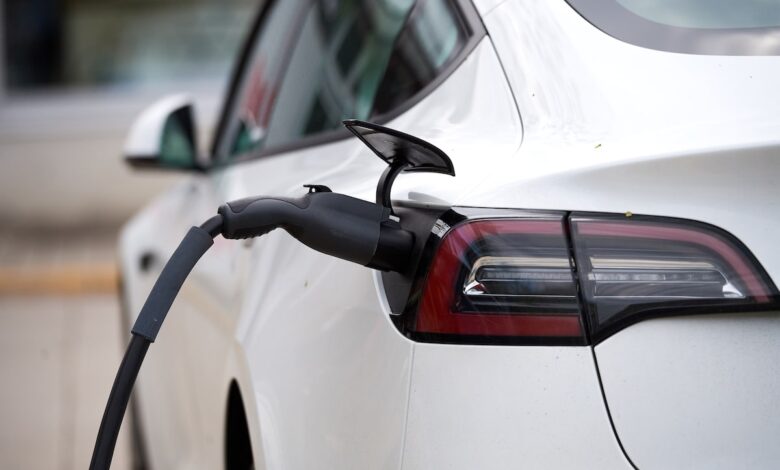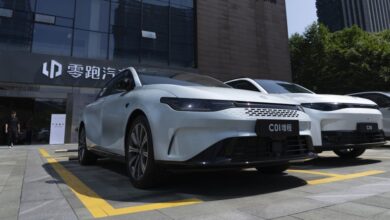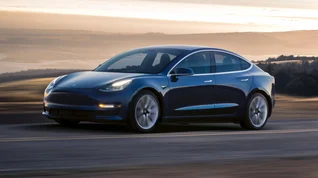Worried about the resale value of your EV? My approach is simple: Don’t sell

A Tesla charges at a reserved electric vehicle parking spot at the Evergreen Brick Works in Toronto on May 4.Sammy Kogan/The Globe and Mail
The risk that comes with owning an electric vehicle is that fancy technology tends not to age very well.
So when I plunked down money on an EV in early 2022, I figured I was making a long-term commitment to a vehicle that might not appeal to second-hand buyers.
My approach then: I planned to drive the car for at least 10 years. I wouldn’t mind if it wasn’t worth much at the end of this period, because a decade of car ownership is full value for me. If it is still a fine vehicle in 2032, that would be an unexpected bonus.
More than two years later, I’m sticking with this approach. Although I have a wandering eye for different colours, my 2022 Hyundai Ioniq 5 still looks great. It runs like a charm, and I can’t think of a single thing that is looking dated.
Well, except that the price of some EVs is now dropping.
Tesla Inc. TSLA-Q, in particular, has been slashing prices on some models to stimulate demand and preserve market share, as competition heats up. The cuts have undermined prices for used Teslas as well, according to a report from CNN that used data from Edmunds.com.
This trend marks a stark contrast to my start with EV ownership, when high demand for vehicles and low supply fed long waiting lists for some models throughout 2022 and into 2023. The idea of price cuts seemed absurd then.
Cheaper EVs are a good development, of course. Lower prices should stimulate demand for cleaner vehicles, which seems like an essential step toward wider adoption. That should create the need for more public charging options and stimulate yet more demand. Looks like a virtuous circle to me.
However, falling prices can leave some consumers regretting their purchases when they realize that they could have saved money by buying later. Widespread regret isn’t a good image. This is why a deflationary economic environment is so feared. A deflationary spiral could explain why EV sales growth has been slowing over the past year, pushing manufacturers to recalibrate their sales forecasts.
Fortunately, I’ve been spared any hand-wringing.
From what I can tell, my vehicle’s value hasn’t been changed. The price of the 2024 version isn’t below what I paid: A beefed-up version, which comes with a bigger battery, costs more. And scanning used versions of my model year online suggests that the value – based on asking prices – is holding up reasonably well.
Even so, I’m under no illusions that my EV is going to stand the test of time.
Hold on there, EV skeptics: I’m not saying that I fear an all-electric future for cars is in doubt. I simply mean that there will likely be advancements within the next decade that could make my state-of-the-art vehicle look like a relic by then.
Already, some manufacturers are beginning to change the types of plugs used to charge EVs. Ford Motor Co. and General Motors Co., for example, are embracing Tesla’s own proprietary connector and gaining access to its enviable North American supercharger network.
More importantly, improvements in battery technology could make today’s versions look limited. And burgeoning public charging infrastructure could make large batteries, which require longer charging times, an unnecessary expense if drivers grow more confident about reaching their next boost.
And then there are likely improvements to self-driving software and new high-tech safety features – the sort of enhancements that can make any new car, gas or electric, look like the next big thing.
So, yes, I could have put off buying an EV in the hope of getting a cheaper, better one years later, and benefiting from a fully formed public charging network. But how many years later? And would I know when the perfect time had arrived?
As it is, I suspect my haphazard timing was okay: Charging options have proliferated along the routes I travel. And I bought the EV when manufacturers were pulling out all the stops to break into Tesla’s market with great cars. The federal government rebate didn’t hurt either.
Sure, I may shed a few tears if EV prices really plummet over the next few years and innovation takes off in a big way. But I suspect the greater risk is with buying a new gas-powered car and expecting it to be relevant in a decade, as EV numbers swell and the infrastructure catering to them becomes ubiquitous.
Even with last year’s slower growth in EV sales, they nonetheless increased by 35 per cent globally, year-over-year, and 40 per cent in the United States, according to the International Energy Agency’s latest global EV outlook. Sales growth is in a lull now. But the shift toward electric is moving ahead.
What’s more, the IEA estimates that 65 per cent of EVs sold last year in China – where falling prices are rattling markets abroad – were cheaper than the average gas-burning equivalent car. That suggests EVs, at least in China, can compete on price, which could mark an important turning point for adoption.
Yeah, I might be driving the electric equivalent of a beater in several years, where inquisitive people ask me: You paid how much? For that? But that’s okay by me.



